The introduction of eSIM and remote SIM provisioning (RSP) to the consumer segment presented Service Providers (SPs) with an opportunity to fully digitalise their services.
Remote SIM provisioning allows SPs to program subscriber profiles remotely, removing the need for a physical SIM card to authenticate the service.
It also enables companies from outside of the telecoms industry to capitalise on eSIM technology.
In this blog, we’ll explain what remote SIM provisioning is, how it works and what are the current RSP options available for the consumer market.
Remote SIM Provisioning
Remote SIM provisioning is an over-the-air process of eSIM profile management. It includes eSIM authentication and activation, enabling, disabling and deleting.
Until 2016, the only way to authenticate mobile devices was through a removable plastic SIM card. SIM cards would have authentication parameters, such as international mobile subscriber identity (IMSI) numbers and the key (Ki), pre-programmed on them. Those parameters couldn’t be changed or deleted. Therefore, if a user wanted to get a new phone number, they had to remove the old SIM card and pop a new one into their device.
The emergence of embedded SIMs in the consumer market facilitated new, fully digital, ways of SIM activation.
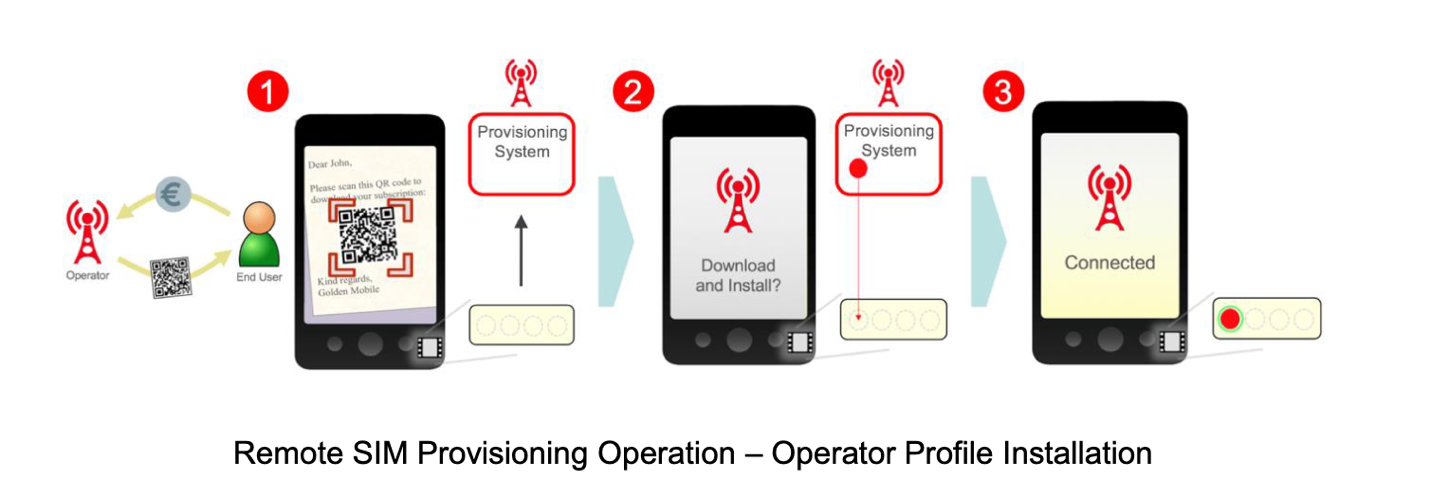
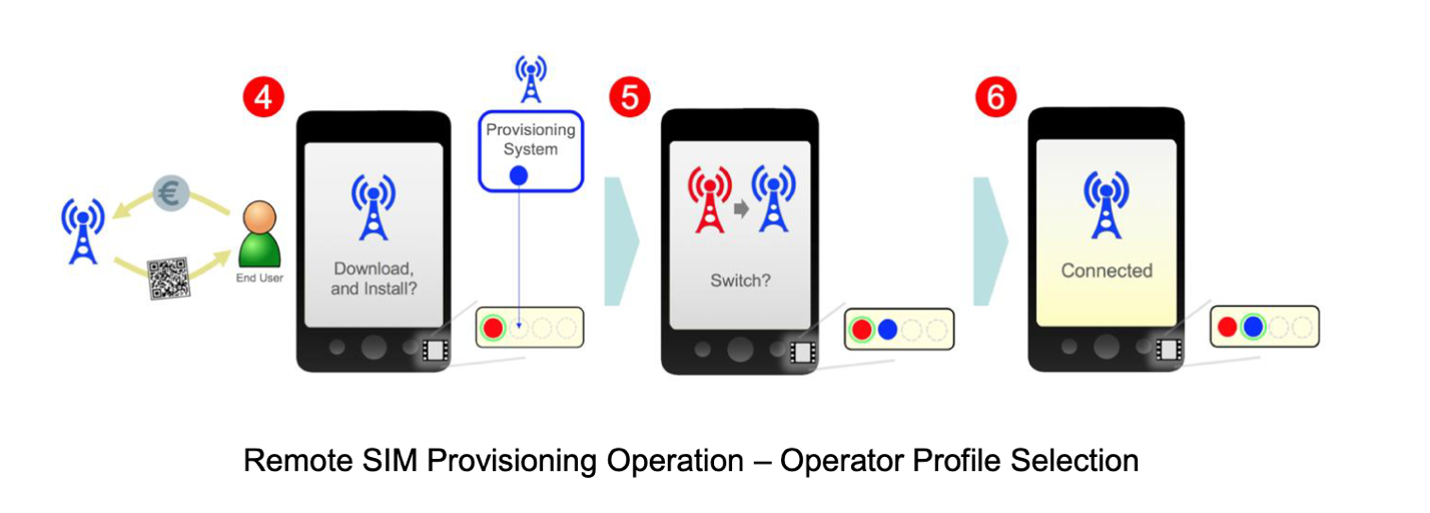 Source: eSIM Whitepaper by GSMA
Source: eSIM Whitepaper by GSMA
How does remote SIM provisioning work?
eSIMs have the same function as plastic SIM cards, however, they work slightly differently.
There are 2 primary elements that make an eSIM:
- the embedded universal integrated circuit card (eUICC), often called an eSIM chip, that is soldered within the device, and
- an eSIM profile – a digital version of the authentication parameters.
When a user wants to connect to a network, they first need to download an eSIM profile to the eSIM chip on their device. Then they need to activate that profile, using one of the methods listed in the next section. That process is called remote SIM provisioning. It’s also responsible for switching from one provider to another, deleting eSIM profiles and more. Everything happens on a user’s device – no need to handle plastic SIM cards anymore!
Thanks to their digital nature, the eSIM chip can accommodate multiple eSIM profiles.
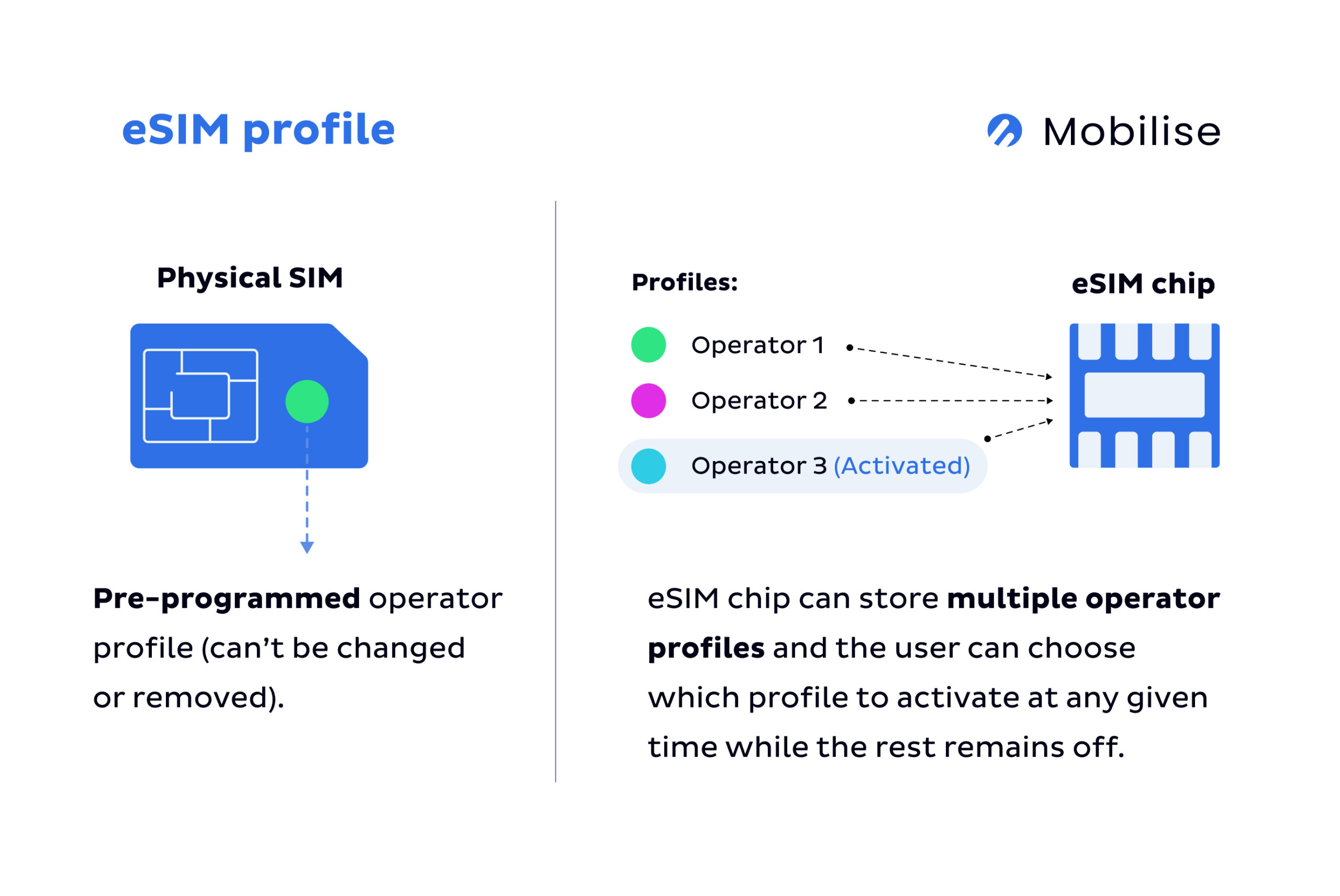
Remote SIM provisioning methods for consumer propositions
Currently, the most popular methods of remote SIM provisioning are:
- Manual eSIM activation
- QR-code based activation
- In-app eSIM activation
Manual eSIM activation
This is the most techy way of activating an eSIM and the least user-friendly one. It’s mostly used as an alternative way of activating eSIM in case other methods fail. For example, when a user doesn’t have another device or a printed-out version of a QR code to scan.
To manually activate an eSIM, the user needs to obtain the SM-DP+ address and an activation code from their SP. It’s usually delivered via email. The subsequent process is slightly different for iOS and Android devices. It may differ even further depending on the specific device.
- iOS (iPhone 13 mini): A user needs to go to Settings > Mobile Service > Add Data Plan or Add eSIM > Use QR code > Enter Details Manually. That’s where they need to type the after-received SM-DP+ address, activation code and optionally, a confirmation code.
- Android (Samsung Galaxy S21 5G): A user needs to open the device settings and follow this process: Settings > Connections > SIM Card Manager > Add a Mobile Plan > Scan Carrier QR Code > Enter Activation Code and input the SM-DP+ address and activation code.
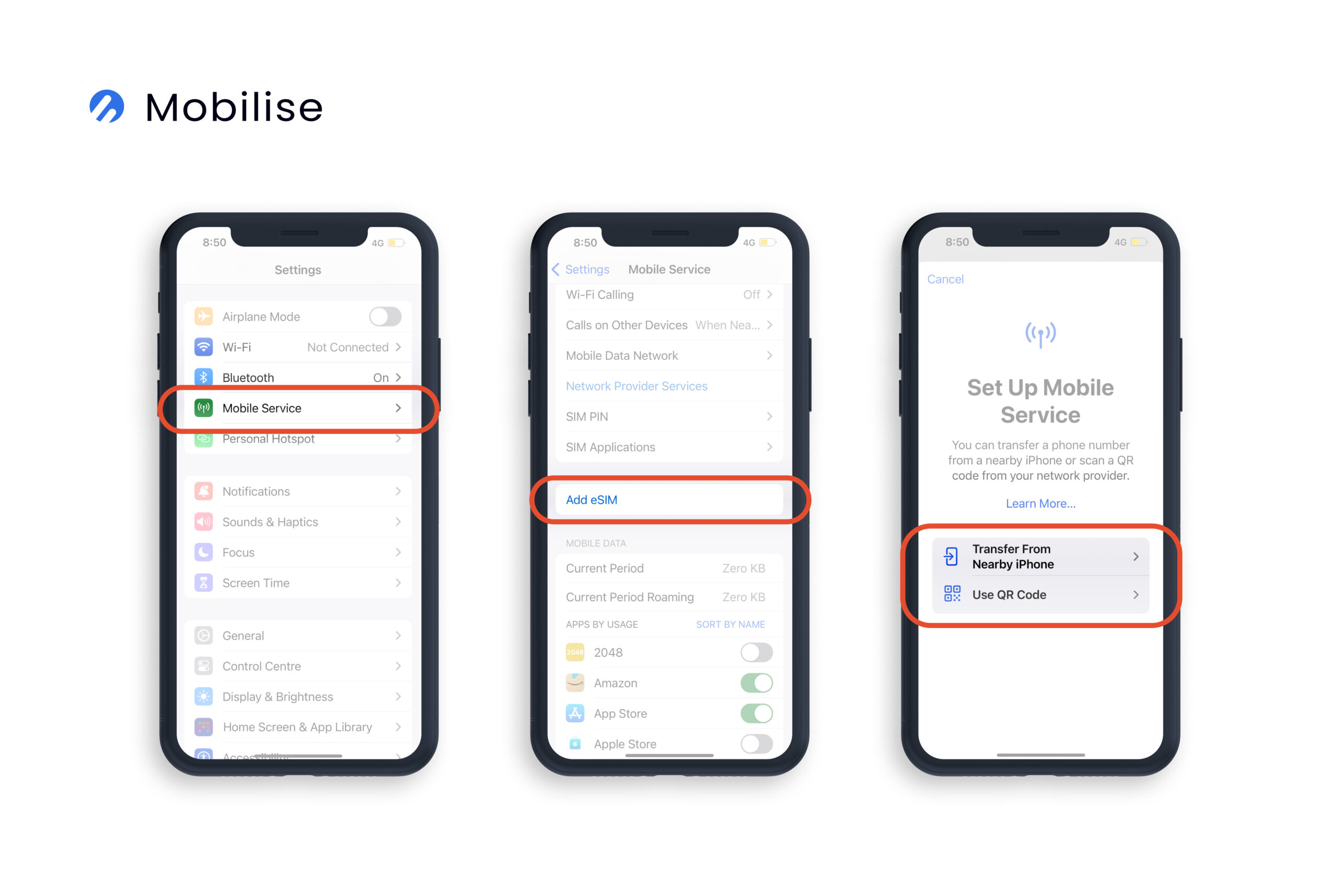
We don’t recommend offering manual eSIM activation as the primary/only option. It may confuse less tech-savvy consumers and discourage them from using eSIM.
QR codes
This method utilises widely known QR codes. After purchasing an eSIM, the user receives a QR code, also via email. The QR code contains the address of the remote SIM provisioning system (SM-DP+). It allows the device to connect to that system and securely download a SIM profile.
QR code eSIM activation is easier than its manual counterpart and thus a lot easier for less tech-savvy audiences to complete. However, it requires another device or a printer to complete – the user must open the QR code on another device or print it out to scan it. That adds another (and unnecessary) step in a user onboarding journey.
In-app eSIM provisioning
Lastly, there is our favourite method of remote SIM provision – in-app eSIM activation. It’s very quick and straightforward. The user downloads the operators’ mobile app and selects their data bundle or subscription plan. Then, they need to, with one tap of the finger, activate their eSIM profile. It only takes up to 60 seconds for the eSIM profile to activate.
How is it done? The mobile application has access to the device operating system APIs. Through this, the app passes the SM-DP+ information to the eUICC chip soldered in the device. That ultimately enables the app to activate, delete and manage eSIM profiles on the device seamlessly.
Mobilise’s eSIM solutions – eSIM as a Service and Embedded Connectivity SDK – utilise in-app eSIM activation, making the onboarding experience quick and simple. In-app eSIM activation is intuitive and there is no need for visual explanation and step-by-step instructions with this remote SIM provisioning method.
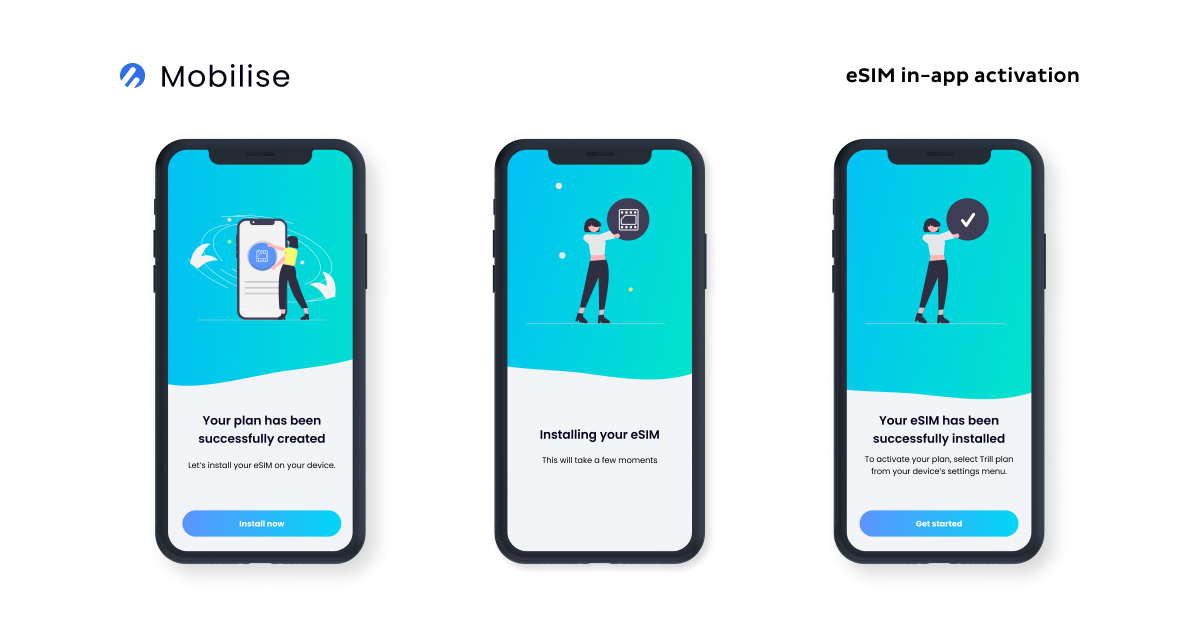
The benefits of remote SIM provisioning
The number of eSIM-compatible mobile devices is rapidly growing – by 2027, there will be 3.5 billion eSIM-capable devices in the world and by 2025 60% of all smartphone unit sales will be eSIM-compatible. Having said that, being unprepared for eSIM can have disastrous results. Remote SIM provisioning will enable all those devices to use eSIMs and bring plenty of benefits for both consumers and service providers:
- Simplified user onboarding – remote SIM provisioning allows for smooth and straightforward user onboarding. No fiddling with flimsy plastic SIM cards is necessary, just a few taps in the device settings to switch from one provider to the other.
- Increased flexibility – eSIMs can store multiple eSIM profiles at the same time and remote SIM provisioning helps enable and disable eSIM profiles at will, so users can manage them across different networks or countries.
- Enhanced security – remote SIM provisioning is an over-the-air process which decreases the possibility of theft of a SIM card and its credentials and use for malicious purposes.
- Lower logistics and operational costs – switching to remote SIM provisioning results in up to 80% reduction in SIM card costs. SPs no longer need to deal with producing, transporting and handling plastic SIM cards. The whole process now happens online.
- Decreased carbon footprint – The carbon footprint of plastic SIM cards is approximately 46% higher than that of eSIMs. No plastic SIM cards and a fully digital remote SIM provisioning process can guarantee a decrease in the amount of plastic being used as well as CO2 emissions.
Remote SIM provisioning with Mobilise
At Mobilise, we’ve combined years of telecom expertise, software development experience and best UX principles to create a portfolio of eSIM solutions for every need. We cater to all types of requirements.
Our white-label eSIM app was created with SPs that don’t have an app store presence in mind.
With our Embedded Connectivity SDK, we can help companies from the telecoms industry and beyond to supercharge their existing mobile apps with eSIM functionality.
Both of our solutions come with in-app eSIM provisioning – the best and most user-friendly remote SIM provisioning option currently in the market.
And we do all the heavy lifting so our clients can focus on their users and products.
To sum up
Remote SIM provisioning is a game-changer. It empowers the users to activate their eSIMs fully remotely – at any time and anywhere. It’s also highly beneficial for service providers. For telcos, it means decreased logistics and operational costs and being able to give their customers what they want – fully digital experiences. Simplifying the onboarding journey for users new to eSIM. For non-telcos, such as travel operators, it’s a new revenue stream that gives them the ability to stay competitive with a unique selling point.
Contact us today to find out what Mobilise’s eSIM solutions can do for your business!



